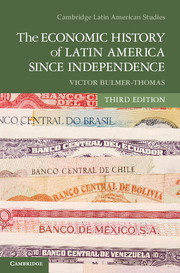Book contents
- Frontmatter
- Dedication
- Contents
- List of Tables, Figures, and Maps
- Preface to the Third Edition
- Preface to the First Edition
- List of Abbreviations
- 1 Latin American Economic Development
- 2 The Struggle for National Identity
- 3 The Export Sector and the World Economy, circa 1850–1914
- 4 Export-Led Growth
- 5 Export-Led Growth and the Nonexport Economy
- 6 The First World War and Its Aftermath
- 7 Policy, Performance, and Structural Change in the 1930s
- 8 War and the New International Economic Order
- 9 Inward-Looking Development in the Postwar Period
- 10 New Trade Strategies and Debt-Led Growth
- 11 Debt, Adjustment, and the Shift to a New Paradigm
- 12 Conclusions
- Appendix 1 Data Sources for Population and Exports before 1914
- Appendix 2 The Ratio of Exports to Gross Domestic Product, the Purchasing Power of Exports, the Net Barter Terms of Trade, and the Volume of Exports, circa 1850 to circa 1912
- Appendix 3 Population, Exports, Public Revenue, and GDP for the Main Latin American Countries before 1914
- Appendix 4 GDP Per Head in Latin America since 1900
- Bibliography
- Index
7 - Policy, Performance, and Structural Change in the 1930s
Published online by Cambridge University Press: 05 June 2014
- Frontmatter
- Dedication
- Contents
- List of Tables, Figures, and Maps
- Preface to the Third Edition
- Preface to the First Edition
- List of Abbreviations
- 1 Latin American Economic Development
- 2 The Struggle for National Identity
- 3 The Export Sector and the World Economy, circa 1850–1914
- 4 Export-Led Growth
- 5 Export-Led Growth and the Nonexport Economy
- 6 The First World War and Its Aftermath
- 7 Policy, Performance, and Structural Change in the 1930s
- 8 War and the New International Economic Order
- 9 Inward-Looking Development in the Postwar Period
- 10 New Trade Strategies and Debt-Led Growth
- 11 Debt, Adjustment, and the Shift to a New Paradigm
- 12 Conclusions
- Appendix 1 Data Sources for Population and Exports before 1914
- Appendix 2 The Ratio of Exports to Gross Domestic Product, the Purchasing Power of Exports, the Net Barter Terms of Trade, and the Volume of Exports, circa 1850 to circa 1912
- Appendix 3 Population, Exports, Public Revenue, and GDP for the Main Latin American Countries before 1914
- Appendix 4 GDP Per Head in Latin America since 1900
- Bibliography
- Index
Summary
The first decade after the First World War brought about further resource shifts in the major Latin American economies in the direction of structural change, industrialization, and diversification of the nonexport economy. In addition, financial and monetary systems were overhauled in many republics – prompted in some cases by the missions led by E. W. Kemmerer – as governments returned to exchange-rate orthodoxy and the gold standard in the postwar years. Without exception, however, economic performance remained heavily dependent on the fortunes of the export sector. By the end of the 1920s (see Table 7.1), exports still accounted for a high proportion of the gross domestic product (GDP), and the openness of the economy – measured by the ratio of the sum of exports and imports to GDP – varied from nearly 40 percent in Brazil to more than 100 percent in Costa Rica.
Structural change in the 1920s brought no diversification within the export sector. On the contrary, the composition of exports by the end of the decade was very similar to what it had been on the eve of the First World War, with a high degree of concentration. The three leading export products accounted for at least 50 percent of foreign-exchange earnings in all republics, and one product accounted for more than 50 percent of exports in ten countries (Bolivia, Brazil, Colombia, Cuba, Dominican Republic, El Salvador, Honduras, Guatemala, Nicaragua, and Venezuela). Virtually all export earnings came from primary products, and nearly 70 percent of external trade was conducted with only four countries (United States, Great Britain, France, and Germany).
- Type
- Chapter
- Information
- The Economic History of Latin America since Independence , pp. 208 - 254Publisher: Cambridge University PressPrint publication year: 2014

